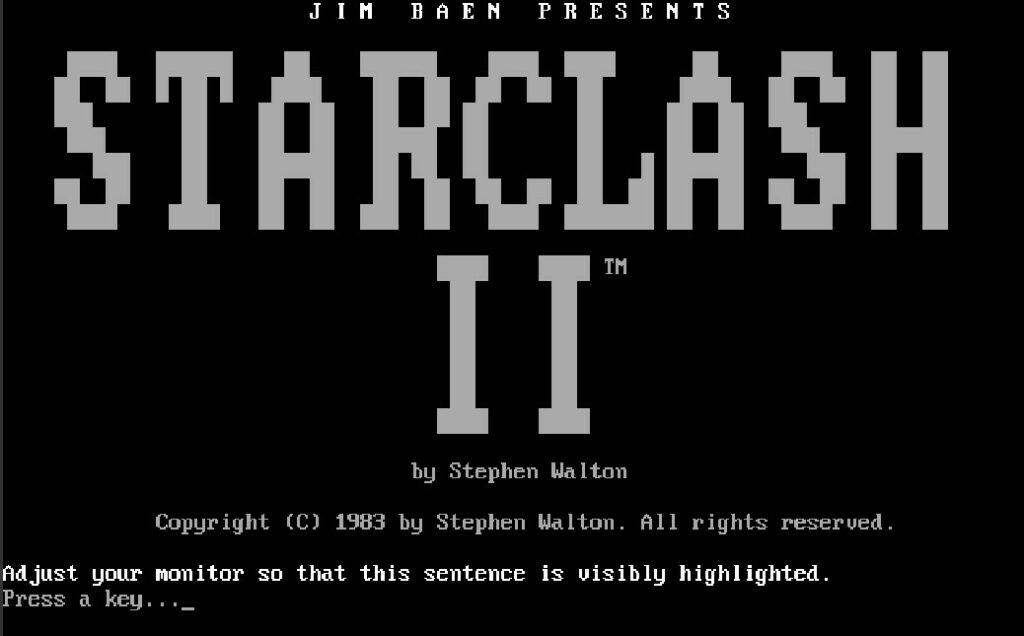
You have 8.51% chance of victory !
So you mean I have a chance ?
Starclash and Starclash II were released respectively in 1980 and 1984 and they could be both described as :
- For Starclash, a TRS-80 Galaxy clone with a computer opponent,
- For Starclash II, a DOS Galaxy clone with a computer opponent, a decent UI and an optional 3D distribution of the systems,
To be perfectly accurate, Starclash is specifically a clone of Galactic Empires, which was the name under which Tom Cleaver initially released the game in 1979, but the differences between Galactic Empires and its 1981 Avalon Hill reedition Galaxy are marginal, and Galaxy is more famous, so I will compare it to Galaxy.
As Starclash has nothing Starclash II does not have, and Starclash II does not have that much either, I will jump directly to Starclash II for this short AAR.
Starclash II starts by offering some options, with the most interesting ones being to handicap a player by giving their opponent more systems. In my experience, anything above one extra system is a huge, almost unbeatable, advantage, so for this AAR I go with only one extra system for my opponents, the Vasudans.

Once I have chosen, the galaxy map appears, in addition to a description of both players’ power.
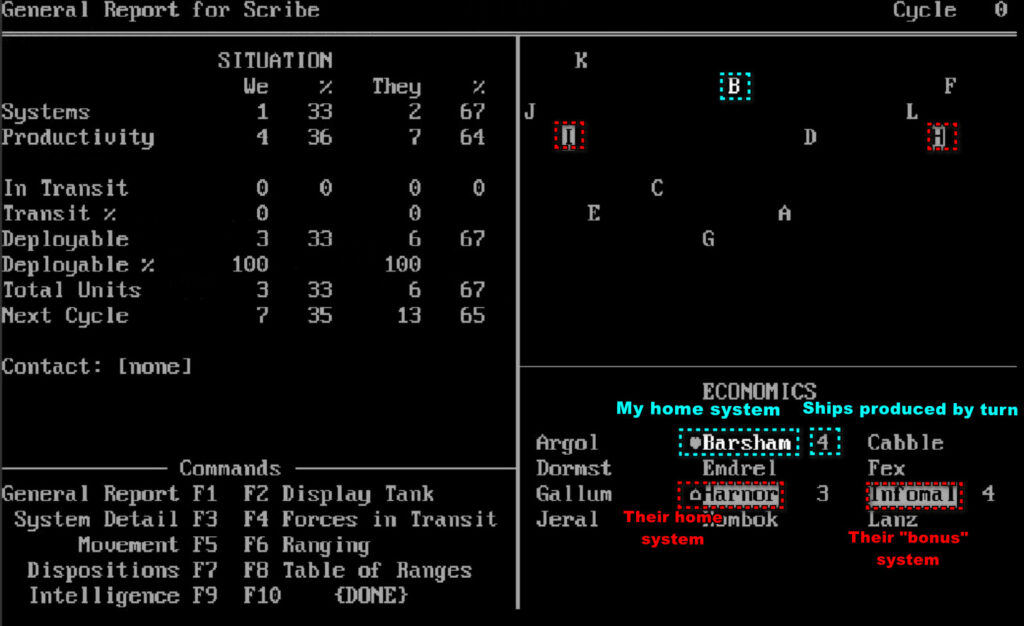
I start in Barsham, strategically located between the two enemy systems. That’s a good start, I can defeat my enemy in details if I play my cards right !
Unlike its predecessors, Starclash II offers a lot of visualisation options. For instance, the top-left corner of the screen above allows you to check how many systems and units both players have, how many units are in transit, and how many units are produced every turn.
But most of the visualization options are totally useless. For instance, you can rotate the galaxy map along both the X and the Y axis :
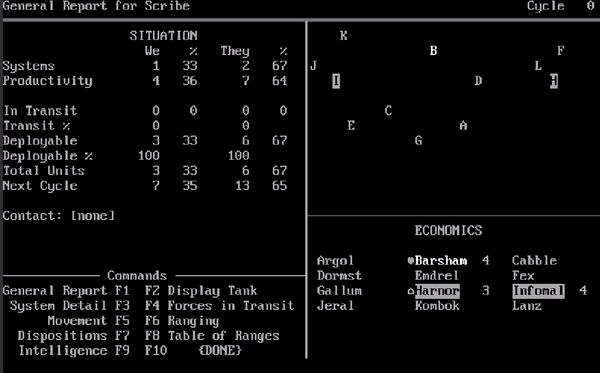
This fancy option is more confusing than useful, especially since what you really care about is the range between one system and another, and that information is available in another menu :
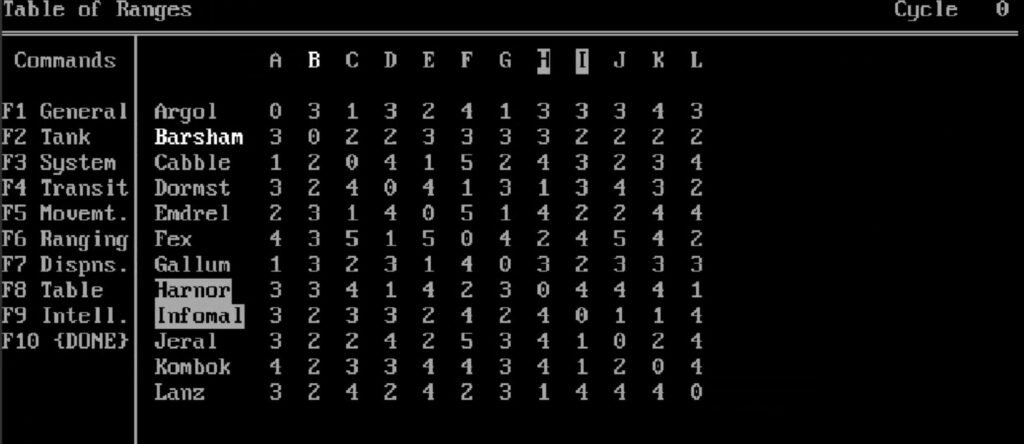
This table of ranges renders obsolete a third option allowing to query the distance between two individual systems. Why would you do that when you have a recap for all systems ?
Final useless, but amusing option : the intelligence report tells you your odds of victory:
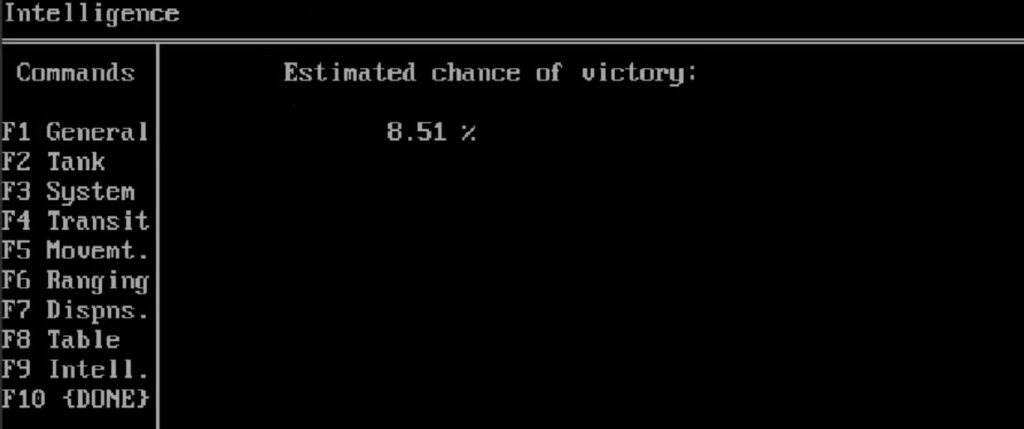
Oh well, I have seen enough Eurovision Song Contests to know the bookmakers can be proven wrong !
Back to the strategic situation. Unlike Galaxy, you can check the status of enemy planets in Starclash, and I realize that out of the 6 starting Vasudan ships, only 1 is in the Harnor system, which also produces less than my own system. I know what I am going to focus on early on.
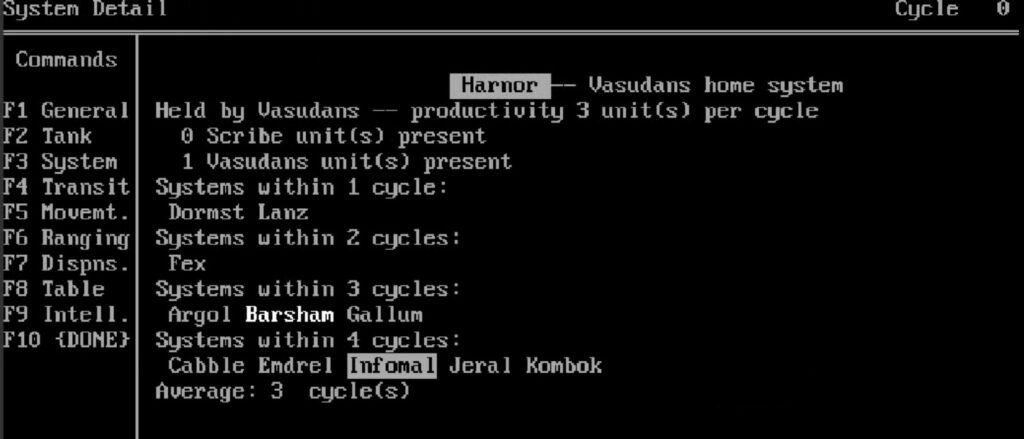
I start with 3 ships, I send one ship each to systems Gallum, Dormst and Lenz. One ship is enough, unlike Galaxy neutral systems are totally undefended. Future reinforcements will be sent to Fex, as it is further away, and then to the other neutral systems.
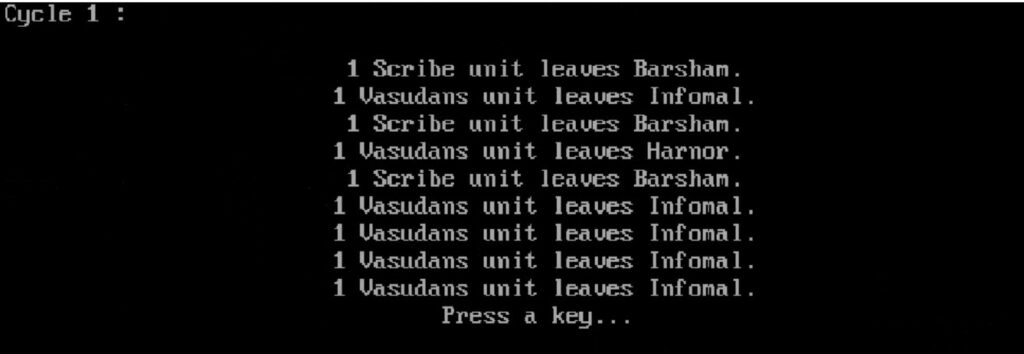
A few turns (“cycles”) later, the first ships arrive. One of my ships encounters a Vasudan ship in Gallum. Both ships are destroyed, but the AI is lucky and still receives the system. I am left with the terrible Dormst (production : 1 ship/turn) and Lanz, next to the enemy home system and outproducing it (4 ships/turn vs 3 ships/turn).
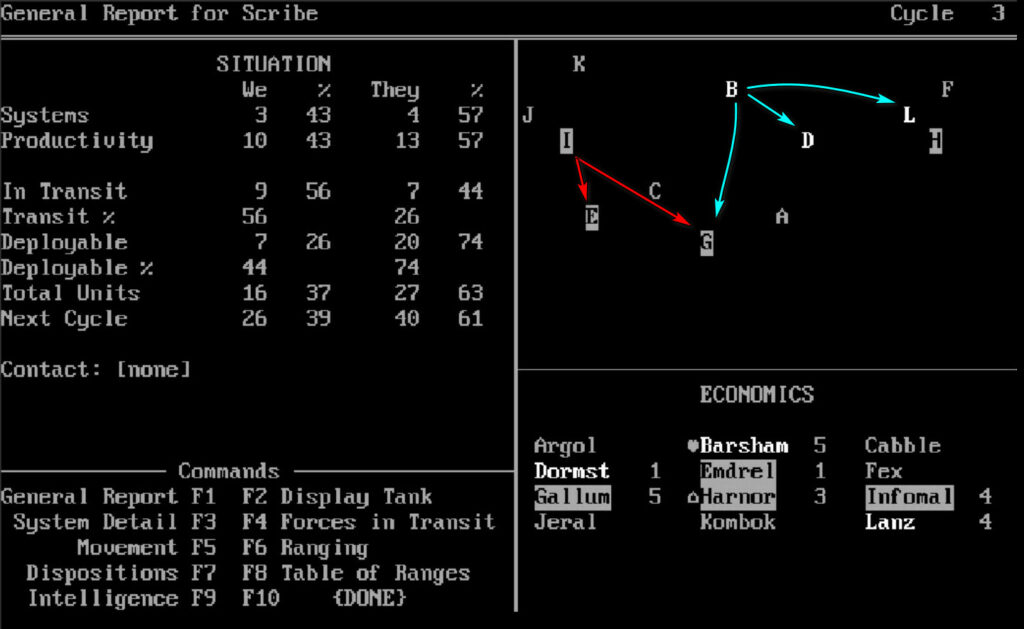
And the following turn, I am happy to find out that I discovered two productive systems with Fex and Cabble. I am now outproducing my opponent (19 ships/turn to 15 ships/turn). Hopefully, the still unexplored-but-next-to-AI Jeral and Kombob are terrible places with dismal production capacity.
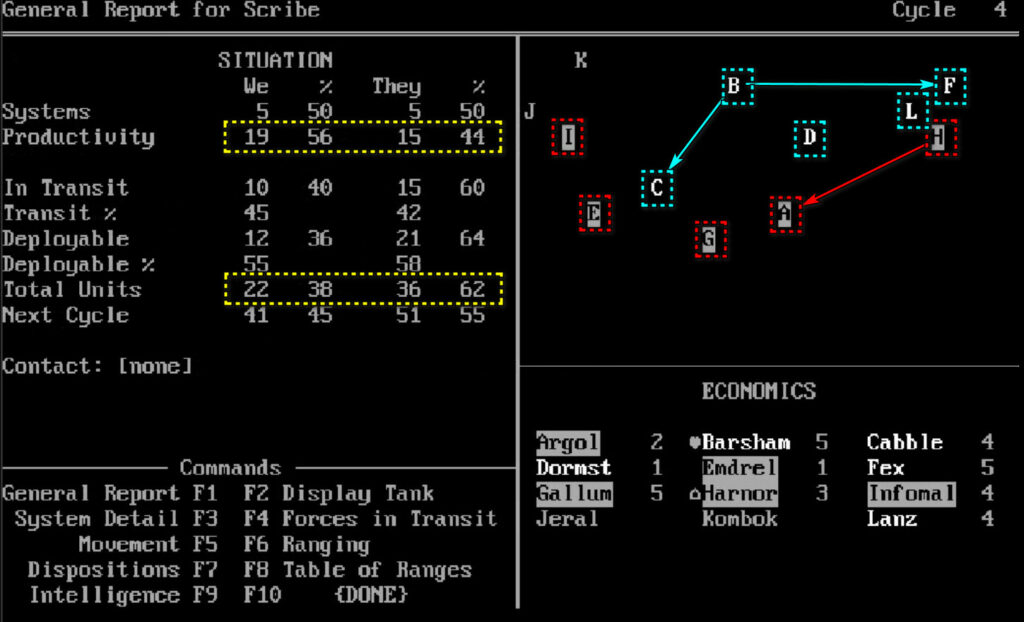
With Lanz and Few under my control, I can now try to attack Harnor, though I need to wait several cycles as my opponent left a garrison of 9 units there that is going to grow as well.
Unfortunately for me, Jeral turns out to be a very productive system, and the production of the other Vasudan systems grows organically. I am soon outproduced again.
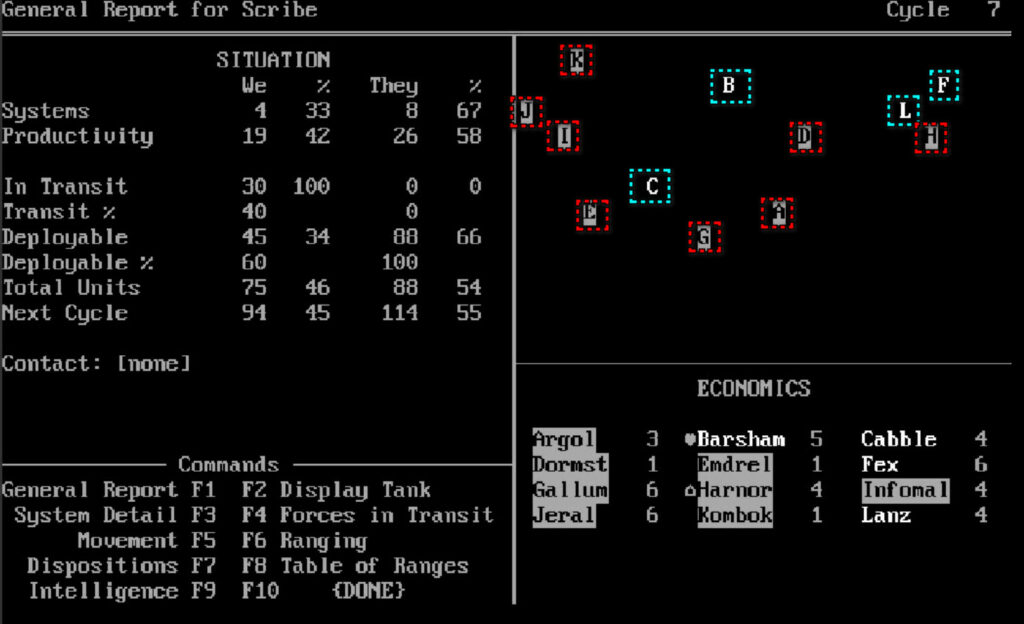
In a rush to turn the situation, I send everything I have in Fex and Lanz to attack Harnor….
… a huge mistake, which triggers my demise. I did not anticipate that the ships from Lanz would arrive one turn before those of Fex. I am the one defeated in details. The forces of Lanz are soundly defeated without causing any significant losses :
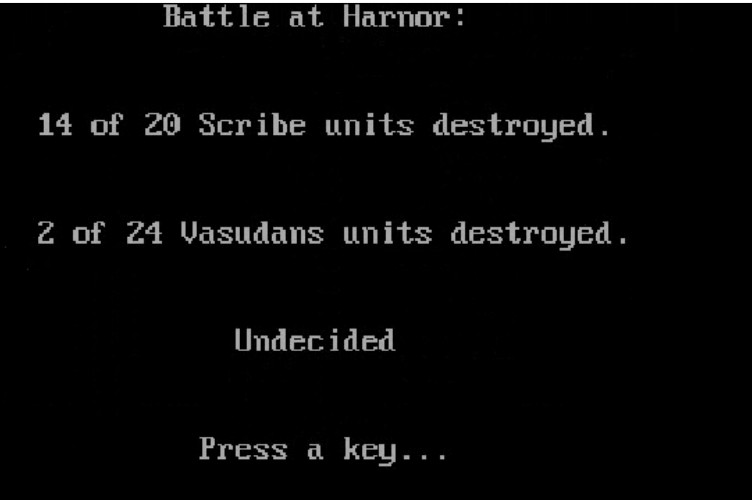
There are a few survivors (another thing you would not see in Galaxy), I did not destroy more Vasudans than Harnor produces, so the reinforcements from Fex do not fare any better :
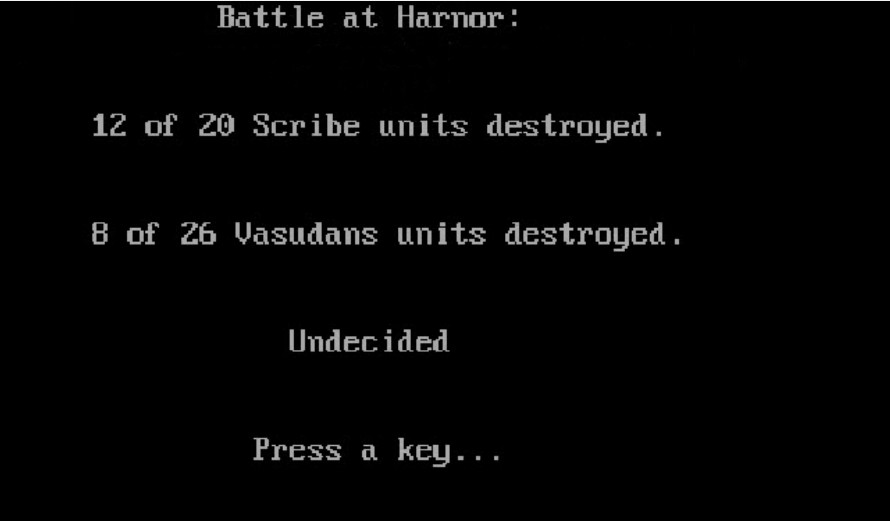
I feed a losing battle in Harnor for a few more cycles, but eventually, I have to abandon my attack.
I am now totally outproduced. I soon lose the depleted Lanz and Fex :
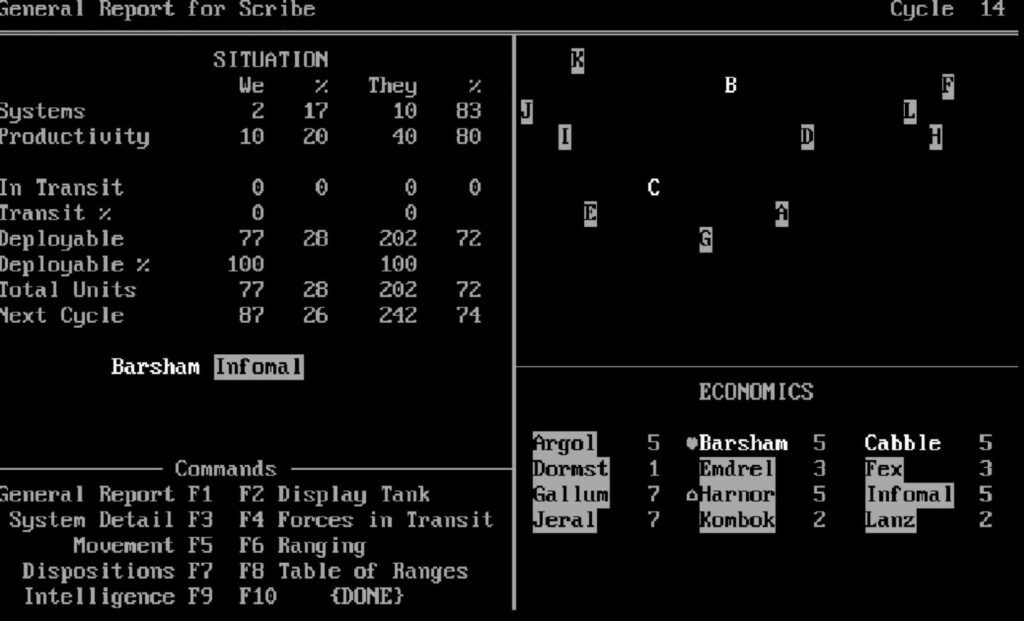
Barsham and Cabble hold a bit longer, I even manage to snatch Informal for a few turns, but I eventually collapse under the number :

The bookmakers were right ; I lost !
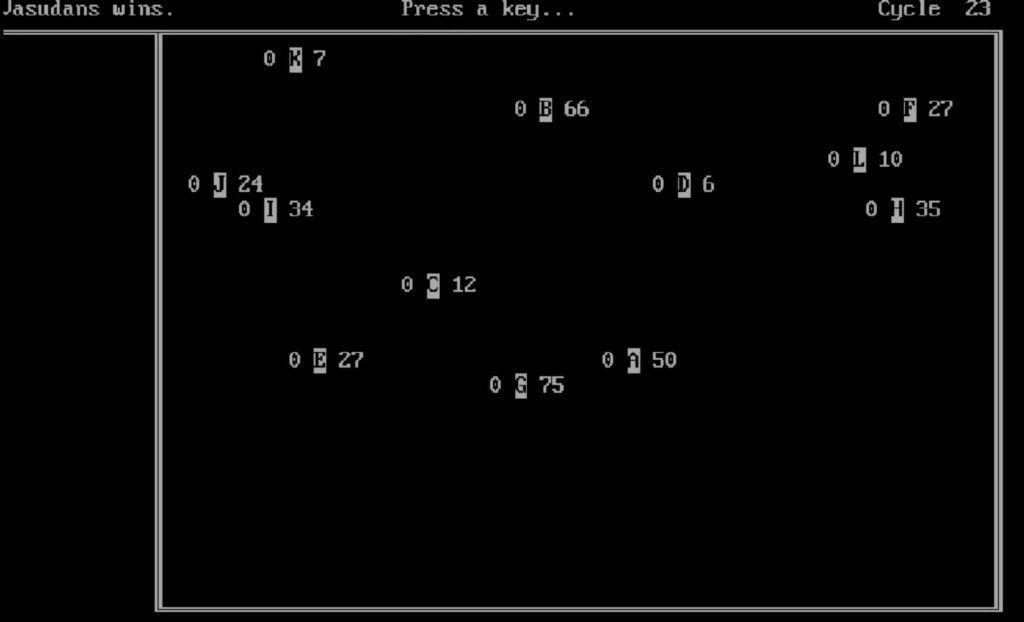
Rating & Review
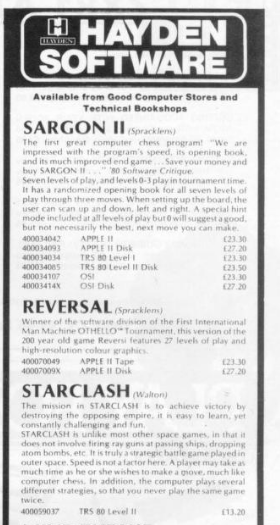
Starclash by Steve Walton, published by the Hayden Book Company,
Starclash II by Steve walton, published by Baen Software,
First release : 1980 (Starclash) and 1984 (Starclash II),
Tested on : TRS-80 emulator (Starclash), DOSBOX (Starclash II)
Total time tested : 3 hours
Average duration of a campaign: 40 minutes for Starclash, half that for Starclash II thanks to improved UI
Complexity: Easy (1/5)
Would recommend to a modern player : No
Would recommend to a designer : No
Final Rating: Obsolete
Ranking at the time of review : 48/61
Starclash and Starclash II are the brainchildren of Steve Walton, a dev all-rounder who only coded one other game (Force 400 in 1986, closer to Chess than to a wargame) but a lot of other software. Both games are really similar, with few differences below :
- Starclash I only allows you to choose a small (10 systems) or a large universe (20 systems), Starclash II any number of systems between 2 and 20,
- Starclash I does not allow you to give yourself extra systems at the beginning of the game,
- Planets are distributed on three dimensions instead of two in Starclash II, but the 3D map does not add anything to the game. At least it can be removed by choosing a depth of 1 when creating the galaxy.
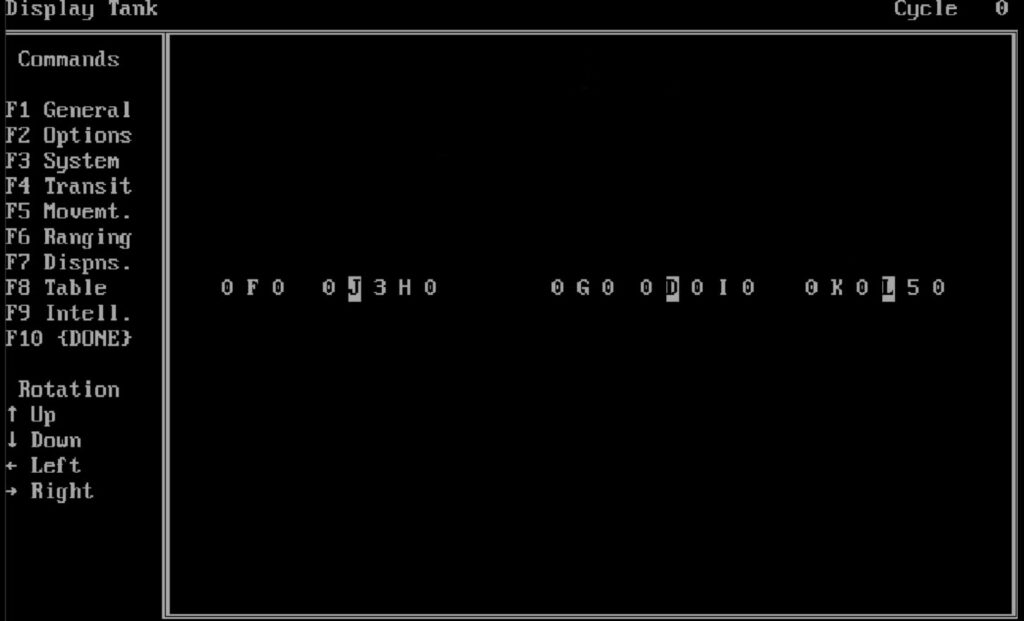
- Both games allow you to access exactly the same information (except the “chance-to-win”), but the UI of Starclash I is a lot harder to navigate as only one set of information is displayed at the same time :

- I also believe the AI of Starclash II is slightly better at defending its systems, but I could be wrong.
The review below is for Starclash II only.
A. Immersion
None.
Rating : Terrible
B. UI, Clarity of Rules and Outcome
Not much to say. The UI is solid, most information is easy to check, and the ruleset is simple. The only thing I don’t understand is how battle results are calculated. Maybe that information is in the manual, but I don’t have it.
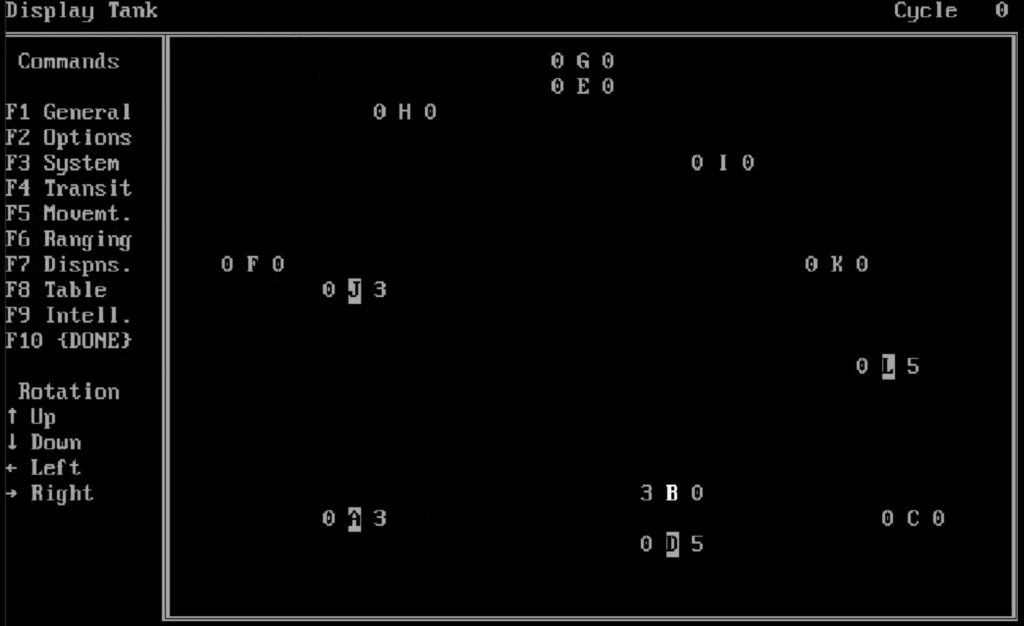
Rating : Good
C. Systems
Fully described. Let’s focus on the differences with Galaxy :
- Differences in scenario set up :
- A maximum of 20 worlds, and the map in general is smaller :
- 5 turns maximum from one system to another in Starclash II, and even then that’s rare,
- Up to 9 turns in Galaxy
- Two players only, Galaxy allowed up to 20 ! On the other hand, no AI in Galaxy,
- No time limit at all in Starclash,
- A maximum of 20 worlds, and the map in general is smaller :
- One minor change that in my opinion does not have any impact : the limited and random organic growth of systems,
- And finally, the three most significant differences :
- Neutral worlds don’t defend themselves – first arrived, first served !
- Battles can last several turns ; in Galaxy battles are immediately solved fully,
- I am not sure how battles are calculated in Starclash, but I have the impression that they favour the defender a lot more (there is no “gunnery factor” to screw up things for the defender).
The three last differences above change the dynamic of the game a lot, in single-player and presumably even more so in multiplayer, with a typical game going on that way :
First, all the neutral worlds will be conquered very quickly – all players will probably send one ship to each of them. By turn 5 at the latest, all systems will be occupied,
Then, there is a short period where the outproduced player can maybe take a local advantage, because a productive system did not have the time to generate a strong garrison yet,
Finally, after this small window of opportunity, the game consolidates. With almost perfect information (knowing which system is important to defend, which system is not well-defended, and when an attack has been launched) and a significant defensive advantage (in the way battles are calculated, and because if a battle lasts several turns, the defender keeps producing ships), it is extremely hard to break even a small advantage. Whoever leads at this point will win, but it will be a slow grind.
From reading the Data Driven Gamer‘s multiplayer AAR of Galaxy, that’s not what happens there. In Galaxy, the neutral worlds are defended and therefore some of them survive until mid- or end game. This leaves open options for the players for much longer (going for neutral worlds, or trying to cripple their opponents) and the game takes longer to stabilize. Even when the game is stabilized, the smaller defensive advantage in Galaxy gives players a better chance to pull the kind of surprise win that changes the course of the game. Finally, longer travel times allow players who are dominated on the strategic map to achieve local superiority.
Of course, this is all theoretical – I never played either Galaxy or Starclash in multiplayer. Still, in single-player, I was frustrated by how long the game felt after a player had consolidated an advantage : turn after turn of offensive or defensive grind which no opportunity to turn the table, a grind that must go until the end because there is no turn limit. Not fun.
Rating : Very poor
D. Scenario design and balancing
There are few customization options but the game randomizes everything, which can create interesting situations, like your opponent being your closest neighbours and starting with 4 ships (you : 2), or your starting system having a production of 1.
The AI is solid, though easy to predict.
Rating : Poor
E. Did I make interesting decisions ?
At the beginning only, after which it is a slow grind.
F. Final Rating
Totally obsolete. There is nothing Starclash does horribly, but this kind of dry “number game” is a thing of the past for a reason. It beats playing Galaxy alone, but only because the latter has no AI. At least, I feel I understand why Galaxy added a very random Gunnery Factor to its battles : so whoever was dominated had a chance to come back on a few lucky rolls
I could not find any review for the game, so no “contemporary review” section on this game. But I have some good news : if I ever meet another Galaxy-clone, I will apply the same policy as I have with Star Trek-clones and just skip it !
6 Comments
“Adjust your monitor so that this sentence is visibly highlighted.”
That has got to win some kind of oldschool gaming award. Talk about period-authentic atmosphere.
“We” and “They” used in the scorekeeping. Someone plays Bridge.
This game has the same problem that most games of the era had – the numbers ensure a tiny advantage in the early game mushrooms into a decisive advantage in the late game. Thus the game is decided in the first few turns and experienced players needn’t even bother finishing. Then, having understood this, why even bother booting the game in the first place?
Galaxy did not slaughter “Nom de guerre”
I initially read that screenshot as “Nonne de guerre”, which, incidentally, would be a great concept for a wargame.
The “Jim Baen presents” on the title screen caught my attention.
Seems Baen was doing computer games before they became the publishing powerhouse.
I recall a rather rare series of computer games from Baen based on the Fred Saberhagen Berserker novels, not sure if they are wargames. Was Starclash at all related to a book series?
Starclash is totally independant.
Indeed, I have a Berserker Raid published by Baen Software in 1984 in my to-do list. It looks like a wargame indeed, and a pretty interesting one.
Interesting, looking forward to that. Akin to Ogre (or Bolo) in space.
Somewhere around here I have the 1982 Berserker boardgame (Flying Buffalo) which was a big flop, mostly due to production issues. Still, it’s the only wargame I know of that has a giant custard pie as playing piece.
This seems like a poorer version of Galaxy by all measures except for the addition of AI, and even then, I always got the impression that Galaxy was at its best with at least three players, for the possibility of alliances, betrayals, etc.
I didn’t play a lot of multiplayer Galaxy, but I never saw anyone make a comeback from a production disadvantage in the rounds I did play. Still, the idea seems more feasible than it does here. Defense can’t be strong everywhere at once, so a player at a slight disadvantage might be able to sneak attack and gain control of a planet major enough to swing the advantage back, but it’s an uphill battle, as even slight production advantages snowball quickly.
Gunnery factor actually makes more sense in this game than it does in Galaxy’s solitaire mode, which is more of a puzzle game, where a bad gunnery factor roll can completely screw up your campaign.